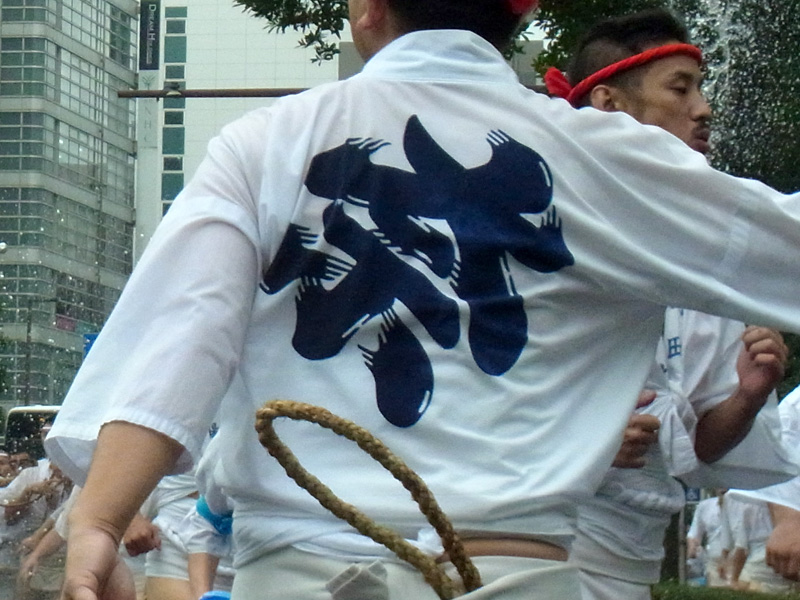This headband is pronouced “Tenogoi” in Hakata and “Tenugui” in the rest of Japan. It consists of a wound up towel with a colour pattern corresponding to the ranking of its wearer. For more about the Tenogoi and the different colour patterns click [here].


Yamakasa Trivia
Extra knowledge for you to enjoy
Traditional Wear
The outfit, traditionally worn during the carrying of the Kakiyama, is called Mizu-happi, which means “Water vest”. There is also the Naga-happi, which is very similar to the water vest, exept that it includes a pair of trousers and a longer Yukata vest.
Both vests are only worn by participants of the Yamkasa, the water vest when carrying the Kakiyama, the long vest for any other occasions around the festivities.
Water Vest (Mizu-happi)

The headband / Tenogoi (手拭)

The water vest / Mizu-happi (水法被)

The vest is only a part of the outfit but gives it its name. Each vest has a pattern correstopnding to the district the wearer is from, often also indicating the subtown of the district. The vest is tightly worn as not to get into the way when carring the Kakiyama. It is mostly white and much shorter than the usual Yukata, in order to keep the wearer cool during the hot days of summer in Japan.
The cloth belt / Haramaki (腹巻)

This belt is to keep the Abdomen warm. While most of the body gets warm quickly when running on a hot day with a Kakiyma on your back, it is important to keep the abdomen and especially the kindneys from getting too cold. This is a more traditional version of the extra abdomen padding, that bikers often use against the wind.
The loincloth / Shimekome (締め込み)

The loincloth is in its binding very similar to the loincloths of somu wrestlers. The only difference is the front part of the cloth haning down and giving extra protection from view. The cloth itself is about three metres long and there are also lots of different designes depending on district and subtown.
The carrying rope / Kakinawa (舁き縄)

This 1.2 to 1.4 metre long rope made of straw is used as an extra security when carring the Kakiyama. The carriers put it around the pole they are stationed at as seen in the picture and can, should they slip or loose footing, grab onto it to prevent falling down and being trampled on.
Socks / Kyahan (脚絆)

Socks, which go up to the knees and are supposed to protect the skin from too much water and the sparks, that occasionally fly up when the metal capped legs of the Kakiyama come against the ground mid run. They are mostly dark blue and worn under Japanese Tabi-shoes.
Tabi shoes / Jikatabi (地下足袋)

These shoes are little more than socks with rubber soles. They cover each toe individually and give good grip on the asphalt. Before the invention of Tabi shoes, the carriers used to run barefoot or with straw sandals. Today the grownup carriers must wear navy blue Tabi shoes, but children running along with them often wear sandals or trainers.
Trivia
Yamakasa Information
History
Even More Information




